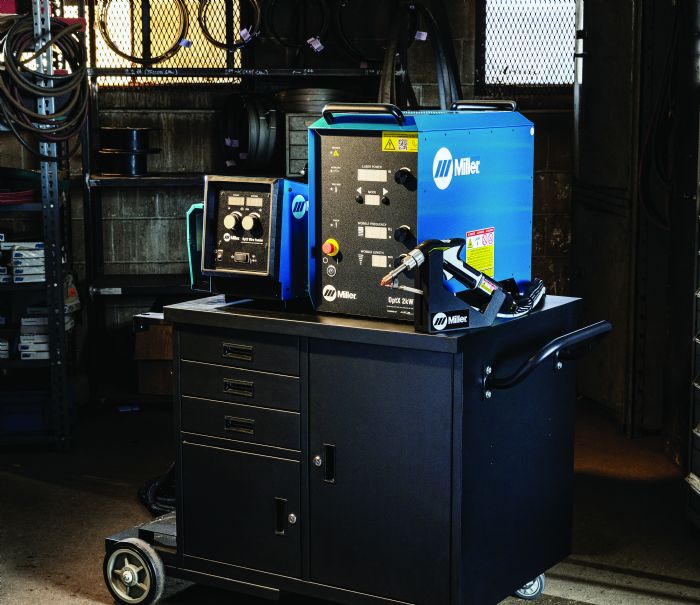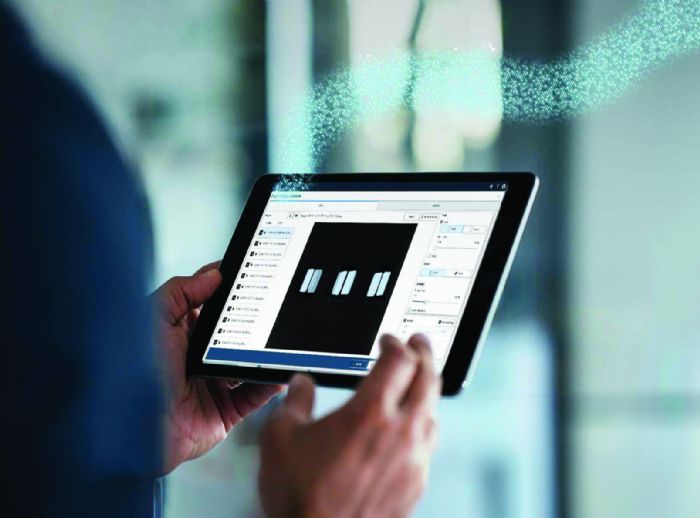Also in the Cobot Systems portfolio, a cobot laser welding package that enables users to automate small-batch production without code programming. Anchored by a Universal Robots cobot enabling six-axis movement, the package includes a touch display and intuitive user interface to ensure a quick learning curve for laser welding setup and use, according to Cobot Systems officials. Included software enables welding parameters to be selected by the cobot.
The pre-engineered package includes a CDRH Class 1 workcell enclosure and access doors; UR10e cobot and laser-delivery utilities dress package; and worktable with modular workholding fixtures and clamps. The package’s IPG Photonics LightWeld laser source reportedly provides consistent, high-quality results across a range of materials and thicknesses, and operates more quickly and simpler than gas-metal-arc and gas-tungsten-arc welding. The package features no-code programming of complex weld paths with optional 3D scanners integrated with stylus and iPad controller. A dual-station option is available for this package.
2-kW Handheld Laser Welder
 From Miller Electric Mfg. LLC comes the OptX 2kW handheld laser welder, designed to boost productivity while helping to combat the ongoing shortage of skilled welders in North America.
From Miller Electric Mfg. LLC comes the OptX 2kW handheld laser welder, designed to boost productivity while helping to combat the ongoing shortage of skilled welders in North America.
Developed collaboration with IPG Photonics, the OptX 2kW reportedly offers rapid and simple training for both new and seasoned welders to drive output and productivity, faster travel speeds and reduced heat input, and the near elimination of pre- and post-weld processing.
The OptX 2kW, according to Miller officials, is best-suited for precision-welding applications with tight fitup, and when needing high productivity without costly automation. Use it on sheet metal of various materials to 5/16 in. thick.
In using this handheld laser welder, among key differences that welders will notice, when compared to conventional welding processes:
- Instead of leaning directly over the weld, welders must lean back or to the side.
- The welding machine “pushes” the weld, directing some of the movement.
- Laser heat is provided by focused light energy, compared to electrical resistance used in arc welding.
- Laser heat is highly focused versus the dispersed heat in arc welding.
- The workpiece is heated from within, starting at the focal point and spreading outward, rather than being heated from the surface with heat being absorbed into the part.
- Laser-welded joints exhibit less distortion than arc-welded joints.
Long-Reach, High-Payload Cobot Laser Welding
 ABB Robotics and IPG Photonics have teamed on a cobot laser welding solution that simplifies the automation of a variety of laser welding jobs, regardless of the user’s experience level, according to ABB officials. Compatible with any of IPG’s LightWeld laser-power sources, the setup features an ABB GoFa 12-kg-payload cobot with a 1370-mm reach, providing the long reach and strength necessary for consistent, high-speed laser welds.
ABB Robotics and IPG Photonics have teamed on a cobot laser welding solution that simplifies the automation of a variety of laser welding jobs, regardless of the user’s experience level, according to ABB officials. Compatible with any of IPG’s LightWeld laser-power sources, the setup features an ABB GoFa 12-kg-payload cobot with a 1370-mm reach, providing the long reach and strength necessary for consistent, high-speed laser welds.
Designed to safely work alongside humans, GoFa offers tool-center-point speeds to 2.2 m/sec.—reportedly outperforming comparable cobots in speed by 14%—with 0.2-mm repeatability. Users can teach the cobot with manual guidance in minutes by moving the robotic arm through the required steps before saving the job with the push of a button. And, a single, intuitive interface enables operators to select and save welding and cleaning presets, adjust laser parameters, and control the robotic arm.
The package’s flexibility and range of motion enable users to tackle a variety of weld types, including any mix of small, large, simple or complex parts, and a range of joints and materials. It also fits easily onto almost any shop floor and is simple to relocate, and features integrated and modular free-standing safety enclosures.
Hybrid Laser Welding for High-Quality, Rapid Aluminum-Battery-Box Production
 Battery packs for EVs typically are housed in various-sized aluminum boxes that require joining during production, with welding as the preferred method. Conventional methods such as gas-metal-arc welding can require lengthy production times and cause distortion, according to Lincoln Electric officials, while aluminum welding via the autogenous laser or friction-stir processes are not fits due to concerns of stress concentrations without the addition of a filler material.
Battery packs for EVs typically are housed in various-sized aluminum boxes that require joining during production, with welding as the preferred method. Conventional methods such as gas-metal-arc welding can require lengthy production times and cause distortion, according to Lincoln Electric officials, while aluminum welding via the autogenous laser or friction-stir processes are not fits due to concerns of stress concentrations without the addition of a filler material.
For EV aluminum-battery-box welding, Lincoln Electric offers Precision Power Laser, which reportedly provides fast travel—three times that of GMAW—and excellent gas-tungsten-arc-quality welds while minimizing distortion. As a completely non-synergic process, no longer do the limitations of an arc define factors such as welding speed, and weld size and quality. Travel speeds surpassing 3 m/min. are possible, depending on material thickness and laser power.
The Precision Power Laser process combines a heated welding wire with a laser beam. Electrical resistance heats the wire to around two-thirds of the melting point, bringing it to a plastic state, before it enters the molten weld pool. Adding heat through the filler metal has proven to be a very efficient way of increasing deposition rates and travel speeds while reducing overall heat input. Special controls in the power supply monitor wire condition and maintain heat into the wire without it going into an arc. In fact, using the Lincoln Electric Power Wave R450 power source with the Precision Power Laser waveform can achieve 500 A of current without breaking into an arc, according to company officials. Precision Power Laser is a flexible process due to waveform control and gap-bridging capabilities of the large-diameter laser spot size.
Custom Laser Welding Components to Full Turnkey Systems
 Kuka Industries offers the ability to supply components; compact cells; modular robotic cells; or fully automated laser welding and hybrid laser welding systems, including the right laser-beam sources, optics and fixtures. The company begins with virtual planning to reduce development times and safeguard investments, with production planning simulated and evaluated prior to installation. Laser welding solutions produce high-quality, visually appealing weld seams, large welding depths, low heat input to minimize component distortion and high process speed. Hybrid laser welding solutions combine the advantages of laser and arc-welding technologies, delivering higher process speeds than arc welding alone with lower heat input, simplified weld preparation and improved aluminum weldability. And, expertise in laser deposition welding processes enables field repairs and targeted application of wearing and functional layers. On request, Kuka Industries can provide automatic component handling, camera-assisted weld-seam inspection, logging of weld parameters and more. MF
Kuka Industries offers the ability to supply components; compact cells; modular robotic cells; or fully automated laser welding and hybrid laser welding systems, including the right laser-beam sources, optics and fixtures. The company begins with virtual planning to reduce development times and safeguard investments, with production planning simulated and evaluated prior to installation. Laser welding solutions produce high-quality, visually appealing weld seams, large welding depths, low heat input to minimize component distortion and high process speed. Hybrid laser welding solutions combine the advantages of laser and arc-welding technologies, delivering higher process speeds than arc welding alone with lower heat input, simplified weld preparation and improved aluminum weldability. And, expertise in laser deposition welding processes enables field repairs and targeted application of wearing and functional layers. On request, Kuka Industries can provide automatic component handling, camera-assisted weld-seam inspection, logging of weld parameters and more. MF
View Glossary of Metalforming Terms
See also: Lincoln Electric Co., Miller Electric Mfg. Co., TRUMPF Inc., ABB Press Automation Solutions, KUKA Robotics Corp.
Technologies: Welding and Joining
Comments
Must be logged in to post a comment. Sign in or Create an Account
There are no comments posted. Welding and Joining
Welding and JoiningLaser Welding of EV Cooling Plates
Yama Fedai Monday, March 31, 2025






 From Trumpf comes the EasyModel AI cloud-based training platform, using the power of AI to support image processing and make manufacturing, and specifically laser welding, even more efficient, according to company officials. Variable, ambient production conditions such as dirt on a weld fixture, reflections from the component or changing light situations adversely affect part recognition and laser-beam positioning. Requiring no prior programming knowledge, the EasyModel AI application creates an algorithm, and the AI filter for Trumpf’s VisionLine Detect image-processing system applies that algorithm to ensure the correct positioning of laser welds.
From Trumpf comes the EasyModel AI cloud-based training platform, using the power of AI to support image processing and make manufacturing, and specifically laser welding, even more efficient, according to company officials. Variable, ambient production conditions such as dirt on a weld fixture, reflections from the component or changing light situations adversely affect part recognition and laser-beam positioning. Requiring no prior programming knowledge, the EasyModel AI application creates an algorithm, and the AI filter for Trumpf’s VisionLine Detect image-processing system applies that algorithm to ensure the correct positioning of laser welds. Cobot Systems offers its turnkey, handheld laser welding unit, using an IPG laser source. It offers adjustable laser welding power to 1500 W, preset and user-defined modes to optimize material-thickness combinations, wobble welding controls for 5 mm of additional weld width, and cleaning power to 2500 W for improved weld quality and finishing capability. And, the unit’s rear panel provides intuitive connections for power, process gas and external-accessory controls.
Cobot Systems offers its turnkey, handheld laser welding unit, using an IPG laser source. It offers adjustable laser welding power to 1500 W, preset and user-defined modes to optimize material-thickness combinations, wobble welding controls for 5 mm of additional weld width, and cleaning power to 2500 W for improved weld quality and finishing capability. And, the unit’s rear panel provides intuitive connections for power, process gas and external-accessory controls.
